The Essential Role of Cuttlebone in Biology
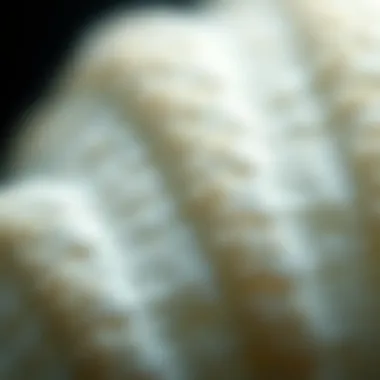
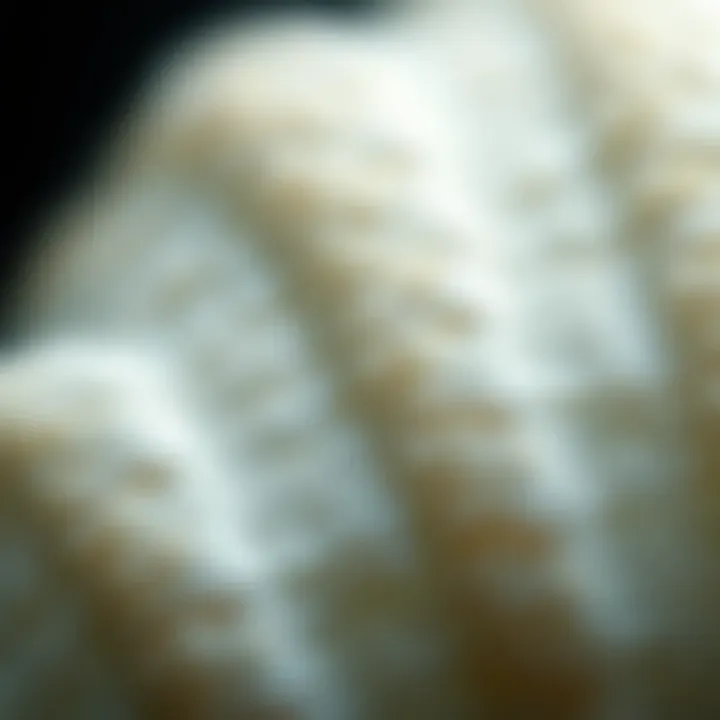
Intro
Cuttlebone is a fascinating structure that often flies under the radar in marine biology. Found within cuttlefish, this unique feature serves multiple purposes, intertwining its existence with the life of these intriguing creatures. When we take a closer look at cuttlebone, we stumble upon a wealth of biological insights that not only shed light on its function in buoyancy control but also reveal its applications beyond the marine realm. From perspectives of aquaculture to innovative materials, the significance of cuttlebone extends far and wide, making it a compelling subject for study.
Key Concepts
Definition of the Main Idea
Cuttlebone, scientifically termed as Dorsal Shell, is a porous internal structure that assists cuttlefish in regulating their buoyancy in water. Comprised mainly of calcium carbonate, it is lightweight yet sturdy, giving cuttlefish the ability to navigate various depths without expending much energy. Now, this isn’t just a passive structure; it also has a dynamic role in enabling cuttlefish to change shape and position swiftly, enhancing their agility in various environments.
Overview of Scientific Principles
The scientific examination of cuttlebone revolves around several core principles:
- Buoyancy Control: The gas-filled chambers within the cuttlebone allow these marine animals to adjust their buoyancy. By manipulating the amount of gas in these chambers, cuttlefish can ascend or descend in the water column effortlessly.
- Chemical Composition: The primary chemical structure consists of calcium carbonate, which lends not just its lightness but also its resilience. The morphology of cuttlebone shows a lamellar structure that maximizes strength while minimizing weight.
- Ecological Impact: Beyond physical properties, these structures have ecological relevance. They offer insights into the evolutionary adaptations of cuttlefish which mirror changes in their environments over time.
Current Research Trends
Recent Studies and Findings
Recent research has highlighted the application of cuttlebone in fields such as materials science. A study suggests that by mimicking the structure and composition of cuttlebone, engineers could develop lightweight yet durable materials for various industries, including aerospace and construction. This exploration opens up avenues for exploring natural structures to create sustainable solutions.
Significant Breakthroughs in the Field
One breakthrough worth mentioning is the advancement in aquaculture that incorporates cuttlebone as a calcium supplement for aquatic organisms. This practice helps maintain healthier environments for marine life, thus promoting optimal growth conditions. The blend of biology and technology continues to enhance our understanding of how cuttlebone plays a role beyond the life of the cuttlefish itself.
"Cuttlebone is more than just a skeletal structure; it's a gateway to numerous applications that can reshape how we think about materials and growth in aquatic systems."
"Cuttlebone is more than just a skeletal structure; it's a gateway to numerous applications that can reshape how we think about materials and growth in aquatic systems."
As we progress in understanding cuttlebone, it becomes clear that the intersection of marine biology and material science can yield remarkable benefits, emphasizing the importance of the often-overlooked cuttlebone.
Prologue to Cuttlebone
Cuttlebone, a fascinating structure inherent to cuttlefish, stands as a remarkable topic worthy of exploration due to its multifaceted role in marine biology. In short, this unique internal shell serves not only as a buoyancy aid but also plays a significant part in the lives of marine organisms. By delving into cuttlebone, we unravel a series of biological processes that affect marine ecosystems and extend into various human applications. Understanding the intricacies of cuttlebone offers crucial insights for students, researchers, and professionals alike.
What is Cuttlebone?
Cuttlebone is the calcified internal shell of cuttlefish, members of the class Cephalopoda. Unlike those of other mollusks, this structure is composed mostly of aragonite and has a unique porous composition. This porous framework allows cuttlebones to be lightweight yet structurally integral. Each species of cuttlefish has its own variation of cuttlebone, which can influence its strength and buoyancy control.
Additionally, the cuttlebone’s shape and size reflect the species' specific habitats and behaviors, showcasing its adaptability. It doesn’t just serve as a hidden floating device; it is also salient in assisting cuttlefish navigate their aquatic landscape, evading predators while efficiently hunting prey.
Historical Context
Historically, cuttlebones have not just been an item of marine biology interest. Ancient cultures recognized their utility, utilizing these structures in a variety of ways. For instance, early Romans used cuttlebones as writing tools or to create molds for objects. In the 19th century, they found their way into personal care markets, often ground into powders for various applications such as cosmetics or medications. The tradition of using cuttlebone continues today, with many people utilizing them to provide calcium supplements for birds.
Additionally, research into cuttlebone has also expanded in recent decades, adding to the treasure trove of knowledge about cephalopod biology and ecology. As we explore this topic further, it becomes clear that cuttlebone possesses an importance that transcends its biological function, echoing through history and into contemporary science.
"Understanding the role of cuttlebone is essential in grasping the broader dynamics of marine ecosystems and the interconnectedness of life within them."
"Understanding the role of cuttlebone is essential in grasping the broader dynamics of marine ecosystems and the interconnectedness of life within them."
The exploration of cuttlebone, therefore, serves as a window into the fascinating complexities of nature. By examining its properties, historical usage, and biological significance, we can appreciate its vital role in both ecological and anthropogenic contexts.
The Structure of Cuttlebone
Understanding the cuttlebone's structure is essential to grasping its function and significance in biological systems. This unique internal shell, primarily composed of aragonite, serves various purposes that play vital roles in the lives of marine organisms. Not only is the cuttlebone critical for buoyancy regulation, but it also provides structural support, which enhances the overall survival of cuttlefish and their relatives. Throughout this section, we will delve into the anatomical features, chemical composition, and variability among species to elucidate the intricate design of cuttlebone and what it represents in marine biology.
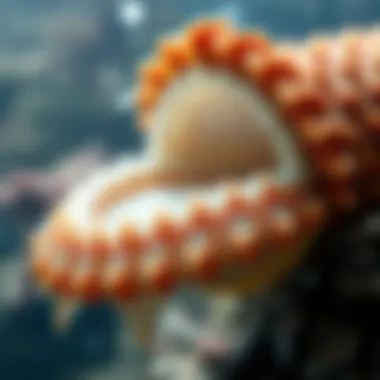
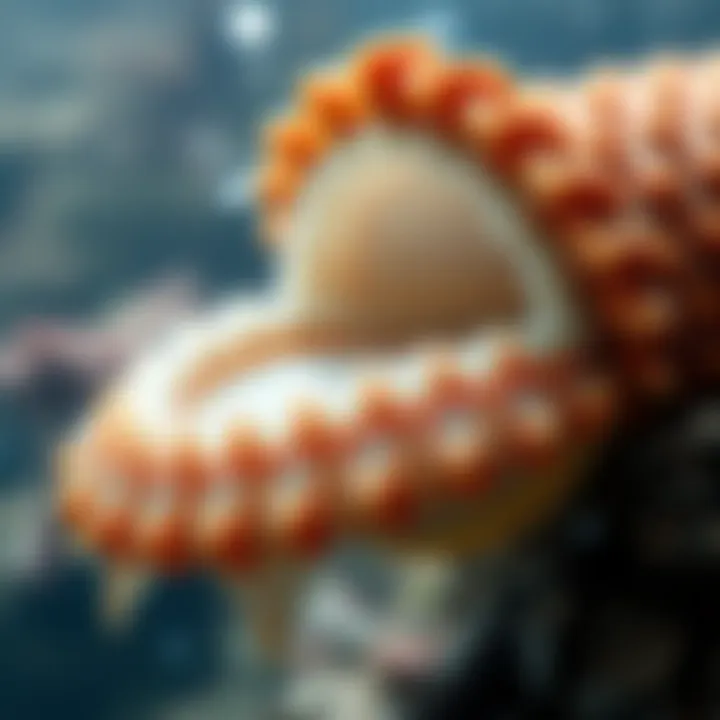
Anatomical Features
The anatomical structure of cuttlebone is quite fascinating. The shape resembles a flattened, elongated bone that is often compared to a boomerang. This unique form allows for an impressive surface area, which aids in buoyancy control. Internally, the structure consists of a series of chambers filled with gas, which can be adjusted to regulate the cuttlefish's flotation. Each chamber acts somewhat like a balloon that can be inflated or deflated as necessary.
"Through its specialized architecture, the cuttlebone exemplifies nature's engineering prowess, showcasing how form and function are intricately intertwined."
"Through its specialized architecture, the cuttlebone exemplifies nature's engineering prowess, showcasing how form and function are intricately intertwined."
The surface of the cuttlebone is smooth and partly covered in tiny holes known as osteons, which contribute to its strength while keeping it lightweight. This features allow cuttlefish to remain agile in the water, evading predators and swiftly engaging in hunting activities.
Chemical Composition
Turning our attention to the chemical composition, cuttlebone is primarily made up of aragonite, a mineral form of calcium carbonate. This choice of material is quite significant, as aragonite is notably lighter than some of its counterparts, which enables effective buoyancy regulation without adding excess weight. Additionally, cuttlebone contains other trace minerals that lend to its structural integrity and resilience.
Here’s a brief look at the key components of cuttlebone:
- Calcium Carbonate: The primary building block, providing both strength and lightness.
- Strontium: Occurs in trace amounts and may enhance the overall density and stability of the cuttlebone.
- Small amounts of Organic Material: While minimal, these contribute to the flexibility and overall structure of the cuttlebone.
Understanding this composition allows researchers to explore not just the evolutionary benefits, but also the potential applications of cuttlebone in various fields, from material science to biotechnology.
Variability Among Species
Cuttlebone is not a one-size-fits-all structure; it presents remarkable variability across different species of cuttlefish. For instance, some species grow larger, possessing broader and thicker cuttlebones, while smaller species develop slender and more elongated versions.
- Common Cuttlefish (Sepia officinalis): This species has a relatively thick cuttlebone, which aids in better buoyancy control in deeper waters.
- Humboldt Cuttlefish (Sepia humboldti): Known for its streamlined cuttlebone, facilitating rapid movement to escape predators.
Factors such as habitat, available resources, and ecological niche all contribute to this variability. Each adaptation can be seen as a testament to the evolutionary pressures that shape not only the cuttlebone structure but also the survival strategies of these fascinating creatures.
Thus, examining the cuttlebone across species not only informs us about the adaptability of cuttlefish but also provides greater insight into marine ecosystems as a whole.
Functional Significance of Cuttlebone
The cuttlebone is more than just a skeletal structure found within cuttlefish; it plays several key roles that are fundamental to the survival and efficiency of these fascinating creatures. Understanding the functional significance of cuttlebone aids in comprehending marine biology's intricate web, providing insight into how life thrives beneath the waves. The focus here will be on three primary aspects: buoyancy regulation, predator protection, and locomotion facilitation.
Buoyancy Regulation
One of the most pivotal functions of cuttlebone is its ability to regulate buoyancy. Cuttlefish are adept swimmers, and their buoyancy allows them to navigate through the water column with ease. The cuttlebone is filled with gas-filled chambers, which can be adjusted to allow the animal to sink or rise in the water. This gas content can also change with pressure, much like a dive watch, enabling the cuttlefish to maintain optimum positioning without expending additional energy.
"The cuttlebone functions like a natural buoyancy aid that allows cuttlefish to perform their delicate underwater ballet efficiently."
"The cuttlebone functions like a natural buoyancy aid that allows cuttlefish to perform their delicate underwater ballet efficiently."
By altering the gas volume within these chambers, cuttlefish can instantaneously adapt to different depths and water conditions. Such adaptability is crucial in predator-rich environments where evasion tactics are essential for survival.
Protection from Predators
Cuttlebone not only aids in movement but also serves as a protective mechanism against predators. Its hard, calcified exterior offers a shield against potential dangers lurking in the deep. When threatened, a cuttlefish can quickly manipulate its movement and use its color-changing abilities to blend into the environment, often aided by the sturdiness of the cuttlebone. The structure provides not only a physical barrier but also enhances their camouflage capabilities.
In addition, the buoyancy regulation linked to cuttlebone plays a role in escape tactics. Cuttlefish can shoot to the surface or dart downwards rapidly, making quick turns or sharp maneuvers to evade capture. This functional synergy between the cuttlebone and the animal’s nervous system showcases the evolutionary advantages conferred by the structure.
Role in Locomotion
Cuttlebone also plays a pivotal role in locomotion, facilitating smooth and controlled movement. With its distinct, external morphology which is lighter than conventional bone, it aids in creating a streamlined shape, reducing drag as the cuttlefish navigate through currents. When in motion, they can utilize jet propulsion, expelling water through their siphon while achieving thrust with the aid of the buoyancy adjustments made possible by cuttlebone.
This aspect of locomotion is vital during hunting. The cuttlefish’s ability to fluidly position themselves and move enables swift strikes at prey, showcasing how effective its biological adaptations can be. The integration of cuttlebone functionality reveals the ingenious designs present in nature that allow organisms to thrive amid their environments.
Cuttlebone in Ecology
Cuttlebone serves numerous ecological functions, intertwining with various biological systems and influencing marine environments. Its multifaceted role goes beyond being a mere skeletal structure of cuttlefish. As a component of the ecosystem, cuttlebone contributes significantly to the health and stability of marine habitats. Understanding this relevance illuminates how the presence of cuttlebone can enhance habitat complexity and subsequently, species diversity. This section delves into two key aspects: the interaction of cuttlebone with marine ecosystems and its impact on biodiversity.
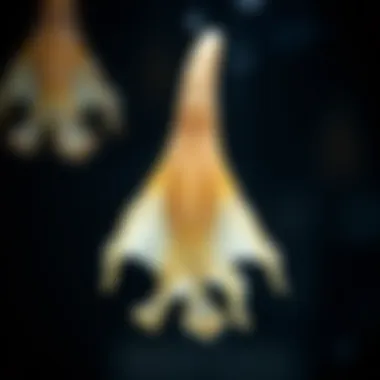
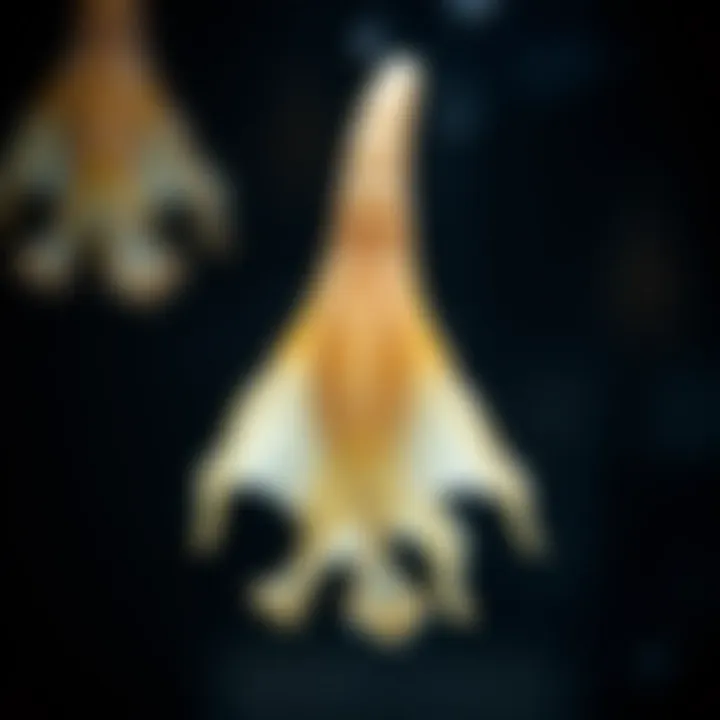
Interaction with Marine Ecosystems
Cuttlebone plays an integral role in the dynamics of marine ecosystems. When cuttlefish die or shed parts of their cuttlebone, these structures descend to the ocean floor. From a distance, they might look like discarded shells, but up close, their chemistry and texture create a whole new narrative in marine ecology.
- Habitat Formation: As they lay scattered on the sea bed, these cuttlebones provide microhabitats for various organisms. Tiny invertebrates and algae can take residence on these structures, effectively turning them into ecosystems of their own. They become a shelter for juveniles of some fish species, protecting them from predators.
- Nutrient Cycling: Furthermore, when cuttlebone breaks down, it contributes calcium carbonate back into the sediment, enriching the mineral composition of the ocean floor. This process helps maintain the balance of nutrients available for other marine life.
"The mere presence of organic materials like cuttlebone influences species interactions and nutrient dynamics in profound ways."
"The mere presence of organic materials like cuttlebone influences species interactions and nutrient dynamics in profound ways."
Impact on Biodiversity
The ecological implications of cuttlebone extend deeply into biodiversity considerations. This structural feature of cuttlefish is not just a skeleton; it is a facilitator of biological diversity and dynamics in the marine world.
- Supporting Diverse Populations: By offering unique habitats and resources to various marine organisms, cuttlebone enhances the variety of species that can thrive in a given area. The organisms that rely on cuttlebone for habitat and nutrition boost the overall ecological health of marine environments.
- Ecosystem Resilience: Additionally, the presence of cuttlebone-derived habitats can lead to increased ecosystem resilience. More complex habitats can withstand environmental stressors better than simpler ones, meaning that these underwater landscapes can support diverse life forms even in changing conditions.
The significance of cuttlebone in this context cannot be overstated. As such, recognizing the myriad ways it interacts with and supports marine ecosystems lays clearer groundwork for further ecological studies and conservation efforts.
Understanding the role of cuttlebone is not just essential for scientists and researchers; it is crucial for anyone invested in marine conservation and the sustainable management of our oceans.
Applications of Cuttlebone
The significance of cuttlebone stretches far beyond its initial biological function. In recent years, the applications of cuttlebone have expanded into various fields, demonstrating its versatility. Each application highlights the unique properties of cuttlebone, fostering innovation and sustainability in practices ranging from aquaculture to material science. Understanding these applications sheds light on the potential that this organic structure holds, promoting a comprehensive view of its importance in modern research and industry.
Cuttlebone in Aquaculture
Cuttlebone plays a pivotal role in aquaculture, particularly in the cultivation of marine organisms. One of the primary benefits is its high calcium carbonate content, which serves as a vital dietary supplement for various fish and invertebrates. This supplement not only aids in the development of a strong skeletal structure but also supports overall health and growth rates.
Moreover, in areas where water quality may affect calcium levels, cuttlebone can be a natural way to ensure organisms receive essential minerals. Fish species such as tilapia often show enhanced growth and resilience when given cuttlebone as part of their feed. This not only improves their market value but also promotes a healthier aquaculture environment. Inserting cuttlebone into aquaculture systems can lead to:
- Enhanced dietary profiles
- Reduced mortality rates
- Increased productivity
The environmental benefits are noteworthy as well. Cuttlebone can be sourced sustainably, even from local suppliers, reducing dependence on manufactured feed alternatives that often contribute to pollution. This makes it a favorable option for aquaculture operations aiming for eco-friendly practices.
Cuttlebone as a Pet Supplement
For pet owners, particularly those with birds and small mammals, cuttlebone is a familiar sight. Its benefits in the pet care industry cannot be overstated. Cuttlebone serves as a natural source of calcium for birds like parrots, canaries, and finches, essential for bone health and egg production.
In addition, offering cuttlebone to pets helps satisfy their natural instinct to chew, which is crucial for maintaining beak health in birds. Moreover, it can prevent obesity, as pets receive vital nutrients without excess calories. Some key highlights of cuttlebone as a pet supplement include:
- Natural source of nutrients
- Promotes physical health
- Supports mental well-being
While primarily beneficial for birds, other small pets like guinea pigs and turtles also gain from the calcium and other minerals found in cuttlebone. It's a small step for pet care enthusiasts that can lead to significant health improvements.
Innovative Uses in Material Science
Cuttlebone is also making waves in material science with its bio-inspired properties. Research has brought to light its potential in developing novel materials with applications in various domains. The unique porous structure of cuttlebone shows promise as a lightweight, yet strong material ideal for engineering applications. Investigations have revealed:
- Potential in Biomedical Engineering: Cuttlebone's natural calcium carbonate framework can be utilized in bone grafting and as scaffolding for tissue engineering.
- Eco-Friendly Composites: It can be mixed with polymers to create biodegradable composites that maintain structural integrity while being environmentally friendly.
- Insulation Materials: Its porous nature presents opportunities for thermal and acoustic insulation in construction materials.
Scientists are continually exploring how the unique characteristics of cuttlebone can lead to advancements in sustainable materials. The ongoing research in this area indicates a trend towards combining nature's designs with human innovation for a greener future.
The versatility of cuttlebone showcases the often-overlooked treasures present in marine biology. Each application reflects not just practical uses but also the potential for harmony between nature and human activity.
The versatility of cuttlebone showcases the often-overlooked treasures present in marine biology. Each application reflects not just practical uses but also the potential for harmony between nature and human activity.
Commercial Value of Cuttlebone
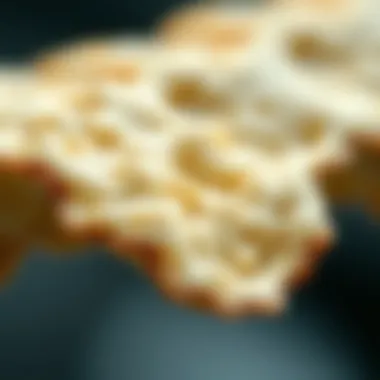
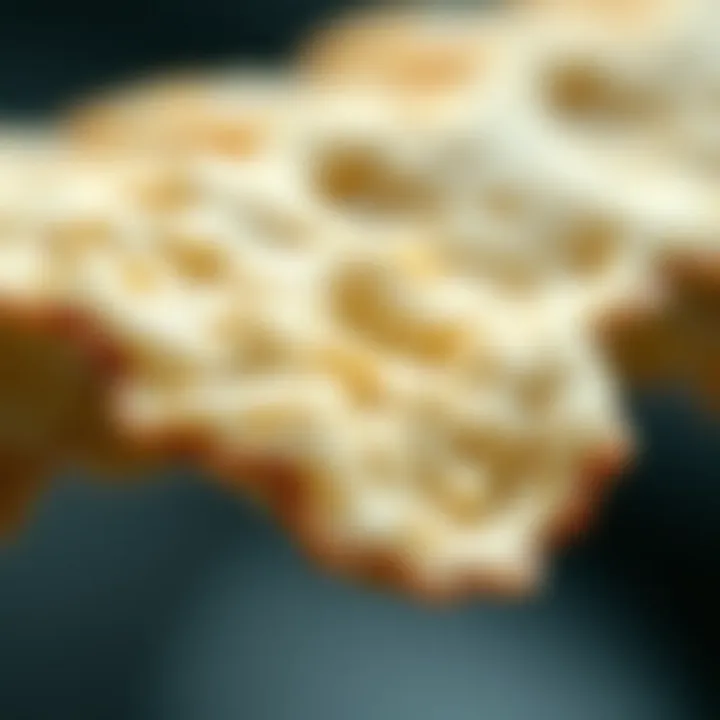
Cuttlebone’s commercial value stretches far beyond its biological essence. Many may perceive it as nothing more than a byproduct of marine life, yet this unique structure holds economic potential that impacts various industries. In this section, we will examine its market trends, demand, and the necessity for sustainable practices in harvesting. Understanding these aspects is crucial for grasping not only the relationship between humans and cuttlebone but also the implications for marine ecosystems and economies.
Market Trends and Demand
The market for cuttlebone is expanding steadily, influenced by its diverse applications. With an increasing number of people recognizing its benefits in aquaculture, agriculture, pets, and even in innovative materials science, it is no surprise that demand is on the rise. In particular, the following factors play a significant role in shaping cuttlebone's market:
- Aquaculture Needs: Cuttlebone acts as a natural calcium source, helping aquatic species strengthen their shells. This is vital in fish farming, where maintaining optimal health directly correlates with yield and profits.
- Pet Care Products: For countless pet owners, especially those with birds such as parakeets and canaries, cuttlebone serves as a dietary supplement that promotes beak and bone health. Its inclusion in pet stores drives customer interest and enhances their daily offerings.
- Material Science Innovations: Research has revealed potential for cuttlebone in producing environmentally friendly materials. As sustainability takes center stage in many industries, cuttlebone’s properties are being explored for use in composites and biodegradable products.
Sustainable Harvesting Practices
As the demand for cuttlebone climbs, sustainability becomes a vital consideration. Overharvesting not only threatens the cuttlefish populations but also disrupts the delicate balance of marine ecosystems. Thus, it’s crucial to adopt responsible harvesting practices. Some effective measures include:
- Regulated Harvesting: Governments and organizations should enforce stringent quotas that limit the amount of cuttlebone harvested annually, ensuring populations can replenish.
- Community Involvement: Engaging local communities in sustainable practices fosters a sense of ownership and responsibility towards marine environments.
- Research and Monitoring: Ongoing scientific inquiry into cuttlefish populations and their ecosystem role can provide data necessary for adapting conservation strategies as needed.
Sustainable practices not only protect marine resources but also ensure long-term economic benefits for those reliant on the cuttlebone market.
Sustainable practices not only protect marine resources but also ensure long-term economic benefits for those reliant on the cuttlebone market.
Maintaining a balance between economic gain and ecological sustainability is imperative. Overall, the commercial value of cuttlebone highlights its importance not just in individual markets, but also in maintaining the delicate fabric of marine life. Understanding these dynamics could pave the way for a brighter, more sustainable future.
Research and Future Directions
Research into cuttlebone is not only crucial for understanding its biological significance but also opens avenues for innovative applications across industries. The unique properties of cuttlebone—its composition, structure, and functionality—make it a focal point for biological and material science studies. Focusing on this area leads to advantages for both academic research and practical applications in various fields, such as aquaculture and biomedicine.
The importance of further study becomes clear when we consider the adaptability of cuttlebone to different environmental conditions. Understanding these variations can enhance our approach to biodiversity conservation and ecosystem management. Moreover, research can aid in recognizing and mitigating threats to marine species that rely on cuttlebone for survival, ensuring the sustainability of these vital ecological components.
Current Studies on Cuttlebone
Several avenues of research currently explore the physical characteristics and potential uses of cuttlebone. One prominent subject is the investigation of its mechanical properties. Cuttlebone's unique structure facilitates buoyancy, enabling cuttlefish to navigate complex aquatic environments. Recent studies have applied advanced imaging techniques to visualize its microstructure at various scales, revealing how this morphology contributes to its lightweight but sturdy nature.
Moreover, research at prominent institutions like the Massachusetts Institute of Technology (MIT) has highlighted the possible applications of cuttlebone in material science. These studies suggest that cuttlebone’s bioinspired design can influence engineering new lightweight yet resilient materials, with implications in the aerospace industry or construction materials.
Potential Innovations in Usage
The potential innovations stemming from cuttlebone research are varied and promising. For instance, biocompatibility studies show that cuttlebone could be used in medical implants and drug delivery systems due to its non-toxic composition and structural integrity. Further investigation into its collagen-like properties hints at applications in regenerative medicine, where it could serve as a scaffold for tissue engineering.
Additionally, as sustainability becomes a focal point in industrial practices, cuttlebone offers eco-friendly alternatives. For example, integrating cuttlebone in biodegradable plastics could diminish the environmental impact typically associated with conventional materials. Researchers are examining the feasibility of creating composite materials that combine cuttlebone with other natural substances, paving the way for products that invigorate green technology.
Understanding how to best harness cuttlebone's attributes could redefine its applications, making it not only a subject of interest within marine biology but a catalyst for interdisciplinary advancements that merge science with practical solutions.
"The exploration of cuttlebone is just the tip of the iceberg in terms of its potential roles in both ecological balance and innovative technology."
"The exploration of cuttlebone is just the tip of the iceberg in terms of its potential roles in both ecological balance and innovative technology."
The continued exploration of cuttlebone's attributes and applications will not only enrich scientific understanding but also drive forward-thinking practices in biodiversity conservation, product development, and more.
Culmination
The significance of cuttlebone in biological systems transcends its simple appearance and function. This unique structure, often relegated to the background in discussions, plays an essential role in various marine processes and applications. From its crucial function in buoyancy regulation for cuttlefish to its increasing importance in fields such as aquaculture and material science, the implications of cuttlebone are profound.
Summary of Findings
Throughout the article, we have explored the multifaceted nature of cuttlebone. Key findings include:
- Anatomical Structure: Cuttlebone is composed of calcium carbonate, which lends it a specialized architecture that allows for buoyancy control in cuttlefish. The varied structures among species highlight evolutionary adaptations in response to their habitats.
- Functional Aspects: It serves not only as a buoyancy aid but also as a protection mechanism against predators and plays a role in locomotion, demonstrating its vital contributions to survival strategies in a marine context.
- Ecological Interactions: The presence of cuttlebone influences marine ecosystems, impacting biodiversity by providing essential nutrients as it decomposes, while simultaneously engaging in symbiotic relationships within these environments.
- Commercial and Innovative Uses: Recent discoveries point to promising applications in aquaculture and even material sciences, where cuttlebone's properties are utilized in various innovative ways, from pet care supplements to advanced biomaterials for sustainable practices.
Final Thoughts on Cuttlebone's Importance
Prioritizing sustainable practices and innovative research regarding resources like cuttlebone may well pave the way for advancements in conservation and materials science. Thus, the future holds great promise for continued exploration and appreciation of this remarkable biological component.
"Cuttlebone is more than just a support structure; it embodies the evolutionary ingenuity of marine life and serves as a lens through which we can view the complex interplay of biology and environment."
"Cuttlebone is more than just a support structure; it embodies the evolutionary ingenuity of marine life and serves as a lens through which we can view the complex interplay of biology and environment."
For those seeking deeper insights or wishing to further their research, resources such as Wikipedia, Britannica, and academic journals found on Google Scholar can provide invaluable information.







